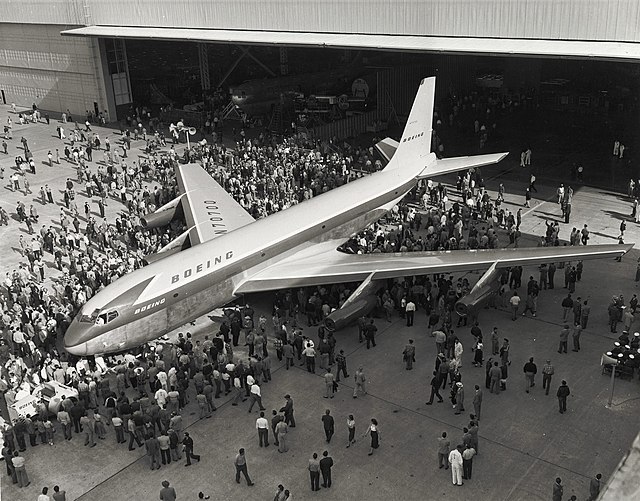The Boeing 367-80 is a retired American four-engined jet prototype aircraft built by Boeing to demonstrate the advantages of jet propulsion for commercial aviation. It served as basis for the design of the KC-135 tanker and the 707 airliner.
Boeing 367-80
The Boeing 367-80 during its roll-out in May 1954
The Boeing 367-80 at Boeing Field in Washington (2000)
Boeing 367-80 (N70700) prototype in a NASA archive photo
Boeing KC-135 Stratotanker
The Boeing KC-135 Stratotanker is an American military aerial refueling tanker aircraft that was developed from the Boeing 367-80 prototype, alongside the Boeing 707 airliner. It has a narrower fuselage and is shorter than the 707. Boeing gave the aircraft the internal designation of Model 717. The KC-135 was the United States Air Force (USAF)'s first jet-powered refueling tanker and replaced the KC-97 Stratofreighter. The KC-135 was initially tasked with refueling strategic bombers, but it was used extensively in the Vietnam War and later conflicts such as Operation Desert Storm to extend the range and endurance of US tactical fighters and bombers.
Boeing KC-135 Stratotanker
A KC-135A refueling a B-52D during the Cold War. Both aircraft types were operated by the Strategic Air Command.
On 11 November 1957, Air Force Vice Chief of Staff General Curtis LeMay tested the first KC-135 on a long-haul flight from Westover Air Force Base, Massachusetts to Buenos Aires, Argentina.
A nose-on view of several re-engined KC-135R aircraft taxiing prior to takeoff. The new engines are CFM56-2 high-bypass turbofans.








